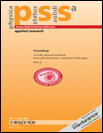Joint FTIR and TPD study of hydrogen desorption from p+-type porous silicon
Abstract
The H-terminated surface of Porous Silicon (PS) has been studied in the past decade basically by means of Fourier transform infrared (FTIR) spectroscopy. In one case only, a temperature programmed desorption (TPD) technique has been applied to an n-type PS sample. However, the evaluation of the amount of hydrogen thermally desorbed has never been attempted. The present work reports the joint FTIR and TPD study of hydrogen desorption from p+-type PS and estimates the amount of hydrogen desorbed in the range 40–850 °C to be around 2 mmol/g. This suggests a ratio between H atoms and surface Si atoms of about one, giving support to the picture of PS as H-covered: as a consequence, only a few bare Si atoms are exposed at the surface and prone to act as adsorption centres, e.g. of NO2. A weak signal, in the TPD curve, is probably associated with the decomposition of a few Si–H–B bulk complexes.




